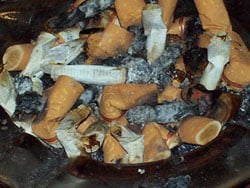Vivisector of the Month!
It’s time once again for my PETA Files feature: our Vivisector of the Month contest. Every month, I read up on two of our nation’s most vile vivisectors and let you, our dear readers, decide on who is the worst by voting.
Before we begin, I would like to congratulate Michael Weed at Johns Hopkins, who won last month’s contest by a landslide. May he forever be recognized for his brilliant work creating a primate crack house—complete with residents infected with the simian form of HIV. Bravo!
This month’s all-girl lineup will be a very tough call, as both vivisectors torture monkeys, mice, and rats. Who you pick will reflect what you think is worse: being tortured like a prisoner of war until your desire for freedom is crushed or being an adolescent alcoholic with no mother to cry to? Please choose wisely!
New Haven, Connecticut, local and Yale professor Marina Picciotto spends her days hidden away in a university laboratory, drugging and tormenting monkeys, mice, and rats—often with the aid of your federal tax dollars! Her chemicals of choice include nicotine, cocaine, morphine, and alcohol—all of which she either feeds or injects into animals before scoring them on bizarre “behavioral assessments,” sometimes with the stated goal of making them suffer.
In one study, Picciotto measured despair in mice by making them swim in pools of water with no resting platform or by hanging them from their tails with tape. For each group, despair was measured by how little they were still willing to struggle for self-preservation. In another study, she bored holes into rats’ skulls so that she could directly inject chemicals into their brains; she then decapitated the animals and froze their heads. In yet another study, this time on learned helplessness, she exposed mice to 360 inescapable shocks.
Her most stunning experiment involved giving monkeys Kool-Aid mixed with liquid nicotine as a sole source of fluid, with the amount of nicotine ingested by one monkey nearly reaching the equivalent of smoking 17 packs of cigarettes per day. Picciotto conducted this experiment to determine how long one should wait after ingesting nicotine before brain imaging is done, despite the fact that researchers went on to take brain images of human smokers in another experiment that could have provided information without caging and drugging monkeys.
Winston-Salem, North Carolina, resident and Wake Forest assistant professor Allyson Bennett is known for her egregious cruelty to monkeys, but she has also dabbled in torturing rats and mice, making her a great match for Picciotto. Lucky for Bennett, Wake Forest now houses nearly 1,500 monkeys and receives loads of federal funding, so she’s unlikely to run out of victims to torment or cash flow to drive her operations.
A queen of seemingly pointless research, Bennett has deprived rats of food for up to two days to observe their consequent behavior in an arena of both food and nonfood objects. To her surprise, food deprivation led animals to come in increased contact with food, despite also inspecting nonfood items out of curiosity. This genius study was funded by the National Institutes of Health (NIH) and conducted at an NIH Animal Center.
In another study, she took baby monkeys away from their mothers and forced them to grow up without parents—causing them emotional distress just so that she could see how this affected right- or left-hand preference. She’s even broken new ground in the research world by investigating whether or not adolescent binge-drinking might be bad for you—if you happen to be a monkey, that is.
Will it be Miss Mouse Depression or the Mistress of Starvation? Leave a comment to let me know!


